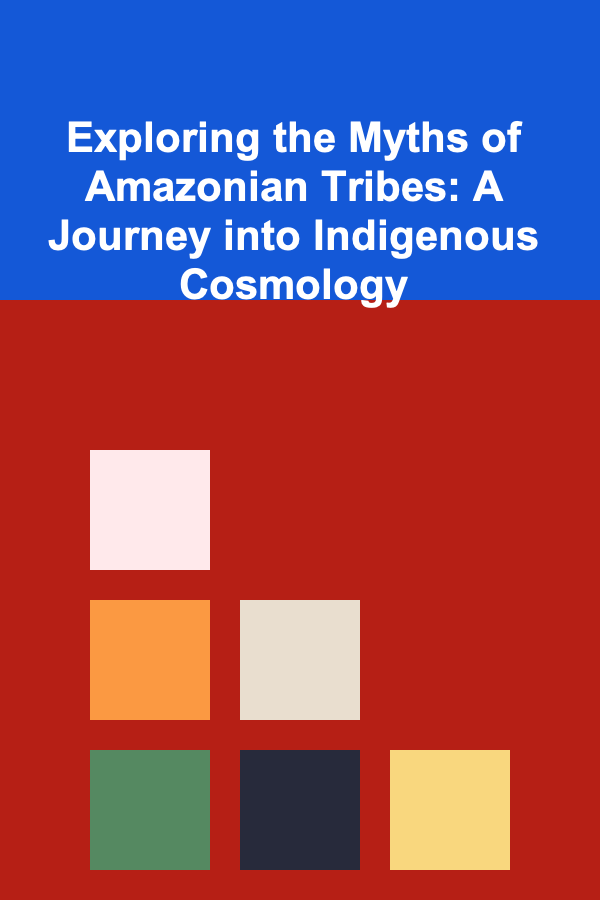
Exploring the Myths of Amazonian Tribes: A Journey into Indigenous Cosmology
ebook include PDF & Audio bundle (Micro Guide)
$12.99$9.99
Limited Time Offer! Order within the next:

The Amazon rainforest, a vast and biodiverse ecosystem, is not only a geographical marvel but also a cultural treasure trove. Home to numerous indigenous tribes, each with its own distinct language, customs, and cosmology, the Amazon holds a wealth of myths and legends that offer profound insights into their worldview and relationship with the natural world. Exploring these myths requires a sensitive and nuanced approach, respecting the cultural integrity and knowledge systems of the Amazonian peoples.
Understanding the Context: Why Myths Matter
Myths are not simply ancient stories; they are living narratives that embody a culture's values, beliefs, and historical experiences. In Amazonian societies, myths serve multiple functions:
- Cosmology and Origin Stories: Myths explain the creation of the world, the origin of humanity, and the relationships between humans, animals, plants, and spirits. They provide a framework for understanding the universe and our place within it.
- Social Structure and Moral Code: Myths often reinforce social norms, roles, and responsibilities. They teach moral lessons, define proper behavior, and maintain social order.
- Ritual and Ceremony: Many myths are closely linked to rituals and ceremonies, providing the narrative context for these practices. They give meaning to the actions performed during these events and connect participants to the spiritual realm.
- Environmental Knowledge: Amazonian myths are often deeply intertwined with the environment. They encode practical knowledge about plants, animals, weather patterns, and sustainable resource management.
- Historical Memory: Myths can preserve memories of past events, migrations, and interactions with other groups. They provide a sense of identity and continuity for the community.
Therefore, when exploring Amazonian myths, it is crucial to understand their multifaceted nature and their integral role in shaping indigenous societies. Ignoring this context risks misinterpreting the stories and undermining their cultural significance.
Ethical Considerations: Respect, Reciprocity, and Representation
Before embarking on any exploration of Amazonian mythology, it is essential to address the ethical implications. These communities have often faced exploitation, displacement, and cultural appropriation. Therefore, a commitment to respect, reciprocity, and responsible representation is paramount.
- Informed Consent: Gaining informed consent from the communities whose myths you wish to explore is non-negotiable. This means clearly explaining your intentions, research methods, and potential outcomes in a language they understand. Consent must be freely given, without coercion or pressure. Remember that consent can be withdrawn at any time.
- Collaboration and Partnership: Engage with indigenous communities as partners, not simply as subjects of study. Involve them in all stages of the research process, from planning and data collection to analysis and dissemination. Value their knowledge and perspectives.
- Respect for Sacred Knowledge: Recognize that some myths are considered sacred and are not meant to be shared with outsiders. Respect these boundaries and avoid seeking out information that is explicitly forbidden. Be mindful of the potential harm that could result from the inappropriate disclosure of sacred knowledge.
- Fair Compensation: If you are receiving funding for your research or plan to profit from the dissemination of Amazonian myths, ensure that the communities involved receive fair compensation for their time, knowledge, and cultural heritage.
- Accurate Representation: Strive for accurate and respectful representation of Amazonian cultures and beliefs. Avoid perpetuating stereotypes or romanticized notions of indigenous life. Present the myths in their original context and acknowledge the diversity of Amazonian cultures.
- Giving Back: Consider how your research can benefit the communities you are working with. This could involve providing access to education, healthcare, or economic opportunities. It might also involve supporting their efforts to preserve their language and culture.
Navigating the Diversity: Recognizing the Plurality of Amazonian Mythologies
The Amazon is home to hundreds of distinct indigenous tribes, each with its unique language, culture, and mythology. It is crucial to avoid generalizing about "Amazonian mythology" as if it were a single, homogenous entity. Instead, focus on the specific myths and beliefs of particular tribes.
For example, the myths of the Yanomami people, who live in the rainforests of Venezuela and Brazil, are very different from the myths of the Tukano people, who inhabit the Colombian Amazon. The Yanomami myths often feature shamanic journeys, encounters with powerful spirits, and the importance of maintaining balance between the human and natural worlds. Tukano myths, on the other hand, emphasize the interconnectedness of all living things, the importance of ancestral knowledge, and the role of ritual in maintaining cosmic harmony.
To truly understand Amazonian myths, it is necessary to engage with the specific cultural context in which they are embedded. This requires studying the language, history, social structure, and ecological knowledge of each tribe.
Key Themes and Archetypes in Amazonian Mythology
Despite the diversity of Amazonian mythologies, some common themes and archetypes emerge:
- The Creator God or Spirit: Many Amazonian tribes believe in a supreme creator god or spirit who brought the world into being. This being may be male, female, or androgynous, and may be directly involved in human affairs or more distant and transcendent.
- Animal Spirits and Totems: Animals play a central role in Amazonian mythology, often serving as spirit guides, totems, or ancestors. Different animals may be associated with particular clans, families, or individuals. Myths often explain the origin of specific animals and their relationship to humans. The jaguar, anaconda, harpy eagle, and various species of monkeys are frequently featured.
- The Shaman: The shaman is a key figure in Amazonian societies, serving as a mediator between the human and spirit worlds. Shamans are believed to possess special powers, including the ability to heal the sick, communicate with spirits, and travel to other realms. Myths often recount the origin of shamanism and the initiation rituals that aspiring shamans must undergo. The use of sacred plants, such as ayahuasca, is often central to shamanic practice.
- The River as a Life Source: The Amazon River and its tributaries are not just waterways; they are considered living entities, imbued with spiritual power. Myths often feature river spirits, mermaids, or water deities who control the flow of the river and protect its resources. The river is often seen as a source of life, sustenance, and transportation, but also as a dangerous force that can bring floods, storms, and disease.
- The Forest as a Sacred Space: The rainforest is regarded as a sacred space, a place of immense power and mystery. Myths often depict the forest as the home of spirits, ancestors, and powerful animals. Certain trees, plants, and locations within the forest may be considered particularly sacred. The forest is also seen as a source of food, medicine, and shelter, but also as a place of danger and hardship.
- The Cycle of Life and Death: Amazonian myths often explore the cycle of life and death, emphasizing the interconnectedness of all living things and the importance of maintaining balance in the natural world. Myths may describe the origin of death, the afterlife, or the process of reincarnation. They often highlight the importance of respecting the dead and honoring one's ancestors.
- Trickster Figures: Many Amazonian mythologies feature trickster figures, characters who disrupt social norms, challenge authority, and often cause chaos. Tricksters can be animals, spirits, or humans, and their actions often have both positive and negative consequences. They can teach valuable lessons about morality, resilience, and the importance of questioning authority.
Methods for Exploring Amazonian Myths
Exploring Amazonian myths requires a combination of academic research, fieldwork, and personal engagement with indigenous communities. Here are some potential methods:
- Ethnographic Research: Conduct ethnographic research in Amazonian communities, spending time with indigenous people, learning their language, and observing their daily lives. Participate in rituals and ceremonies, if invited, and engage in conversations about their beliefs and worldview. Take detailed notes and record interviews, always with informed consent.
- Linguistic Analysis: Study the languages of Amazonian tribes, as language is often closely tied to culture and mythology. Analyze the structure and vocabulary of the language, paying attention to words and phrases related to cosmology, spirituality, and the natural world. Explore how myths are transmitted orally and how language shapes the narrative.
- Comparative Mythology: Compare Amazonian myths to those of other cultures, both within and outside of South America. Look for common themes, archetypes, and motifs, and explore how these similarities and differences can shed light on the human condition and the evolution of cultural beliefs. Be cautious about imposing Western frameworks or interpretations on Amazonian myths.
- Ethnobotany: Study the relationship between indigenous people and plants, as many Amazonian myths are closely linked to ethnobotanical knowledge. Learn about the medicinal, nutritional, and spiritual uses of plants, and explore how these uses are reflected in myths and rituals. Work with indigenous healers and shamans to gain a deeper understanding of their knowledge of plants and their role in maintaining health and well-being.
- Archaeological Research: Explore archaeological sites in the Amazon to gain insights into the history and culture of ancient civilizations. Examine artifacts, such as pottery, tools, and ceremonial objects, and look for clues about their beliefs and practices. Consider how archaeological evidence can complement and inform the study of Amazonian myths.
- Artistic Interpretation: Engage with Amazonian myths through artistic mediums, such as painting, sculpture, music, dance, and storytelling. Create your own interpretations of the myths, drawing inspiration from the original narratives and your own personal experiences. Share your art with others and use it as a tool for promoting cultural understanding and appreciation.
- Literature Review: Conduct a thorough review of existing literature on Amazonian mythology, including academic articles, books, and indigenous publications. Identify gaps in the research and areas where further exploration is needed. Be critical of the sources you consult and consider the perspectives of different authors.
Specific Examples of Amazonian Myths
To illustrate the richness and complexity of Amazonian mythology, let's examine a few examples:
- The Myth of Yurupary (Various Tribes, including Tukano): This myth, widespread among several tribes in the Amazon, tells the story of Yurupary, a powerful being who established the laws and customs of the tribe. He is often associated with sacred flutes and trumpets, which are used in rituals to invoke his presence. The myth emphasizes the importance of respecting ancestral traditions and maintaining social order. Versions differ significantly between groups; some restrict the handling of Yurupary instruments and knowledge to men, reflecting social structures.
- The Anaconda as Creator (Desana): In Desana mythology, the Anaconda is a powerful creator being who shaped the Amazon River and the surrounding landscape. The Anaconda is seen as a symbol of fertility, life, and transformation. The myth highlights the importance of respecting the river and its resources.
- The Jaguar as Shaman (Various Tribes): The jaguar is often associated with shamanic power and transformation. In many Amazonian tribes, the shaman is believed to be able to transform into a jaguar, allowing them to travel between the human and spirit worlds. The myth emphasizes the connection between humans, animals, and the spiritual realm.
- The Ayahuasca Vine as Teacher (Various Tribes): The ayahuasca vine is a sacred plant used in many Amazonian cultures for healing and spiritual exploration. Myths often tell of how the ayahuasca vine was discovered and how it can be used to connect with the spirit world. The vine is seen as a teacher, guiding individuals on a journey of self-discovery and transformation.
Challenges and Pitfalls
Exploring Amazonian myths is not without its challenges. Here are some potential pitfalls to be aware of:
- Cultural Appropriation: Avoid appropriating Amazonian myths for your own purposes without understanding their cultural context and significance. Be respectful of indigenous intellectual property rights and avoid commercializing or misrepresenting their cultural heritage.
- Romanticization: Avoid romanticizing indigenous cultures or portraying them as inherently "primitive" or "noble." Recognize the complexities and challenges of life in the Amazon and avoid perpetuating stereotypes.
- Generalization: Avoid generalizing about "Amazonian mythology" as if it were a single, homogenous entity. Recognize the diversity of Amazonian cultures and focus on the specific myths and beliefs of particular tribes.
- Ethnocentrism: Avoid imposing Western values or perspectives on Amazonian myths. Try to understand the myths from the perspective of the indigenous people who created them.
- Loss of Original Meaning: Be aware that myths can change and evolve over time, and that the original meaning may be lost or distorted. Try to access the most authentic and reliable sources of information possible.
- Misinterpretation Due to Translation: The nuance and symbolism present in the original language can be lost or altered during translation. Whenever possible, work directly with the indigenous language or use translations vetted by community members.
The Future of Amazonian Mythology
As the Amazon rainforest faces increasing threats from deforestation, mining, and climate change, the survival of Amazonian cultures and their myths is at stake. It is crucial to support indigenous communities in their efforts to protect their land, language, and cultural heritage.
By exploring Amazonian myths in a respectful and responsible way, we can gain a deeper understanding of the human condition and the interconnectedness of all living things. We can also learn valuable lessons about sustainability, resilience, and the importance of preserving cultural diversity.
The preservation of Amazonian mythology is not just about preserving the past; it is about ensuring a future where indigenous voices are heard, their knowledge is valued, and their cultures thrive.

How to Organize Your Email Inbox for Efficiency
Read More
How to Stage Your Home with Art and Decor
Read More
How to Use a Pegboard for Creative Organization
Read More
How to Use Deep Learning for Passive Income in the Gig Economy
Read More
How to Lead Diverse Teams Effectively
Read More
How to Plan Your Finances with a Monthly Planner
Read MoreOther Products

How to Organize Your Email Inbox for Efficiency
Read More
How to Stage Your Home with Art and Decor
Read More
How to Use a Pegboard for Creative Organization
Read More
How to Use Deep Learning for Passive Income in the Gig Economy
Read More
How to Lead Diverse Teams Effectively
Read More